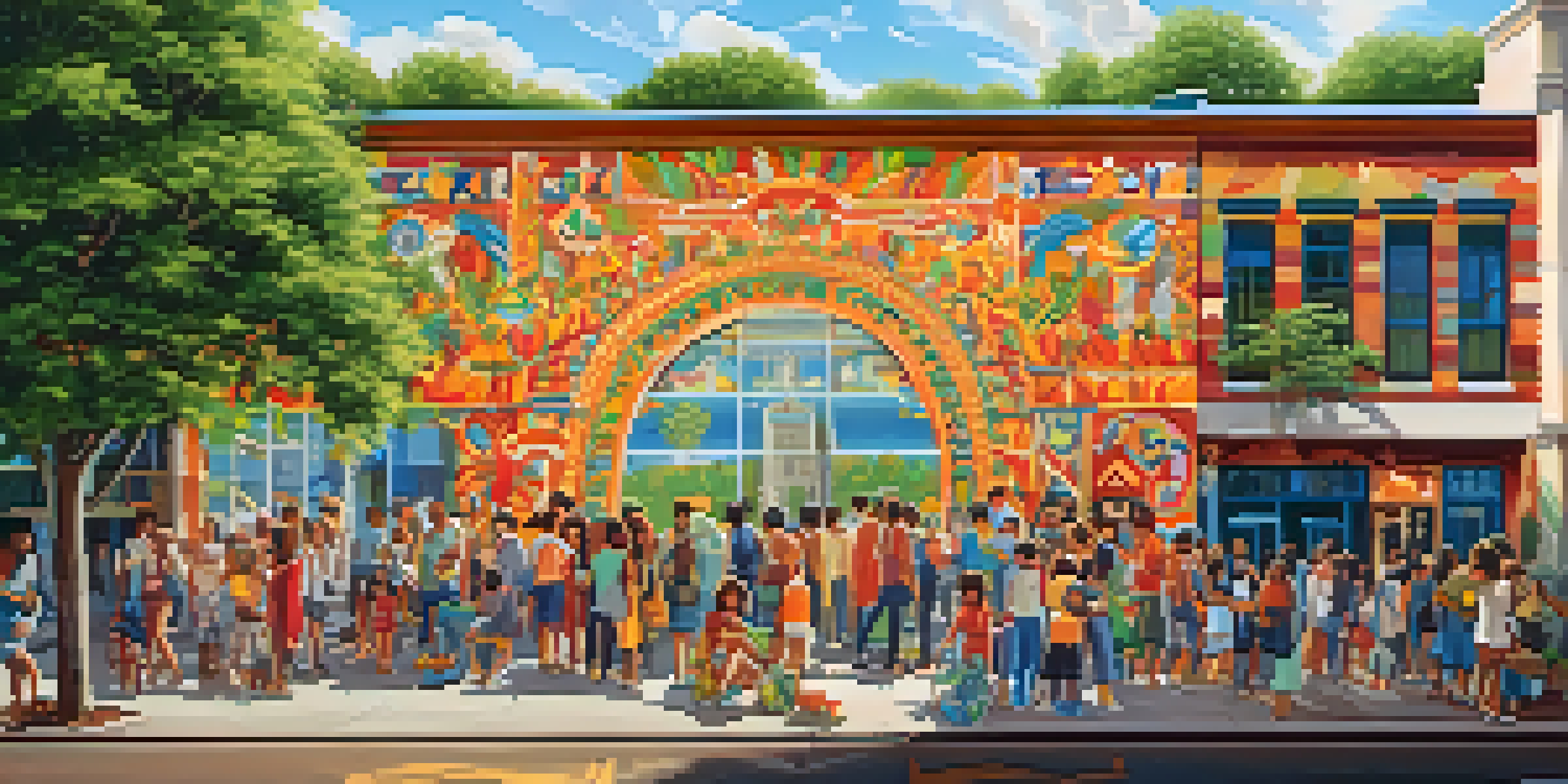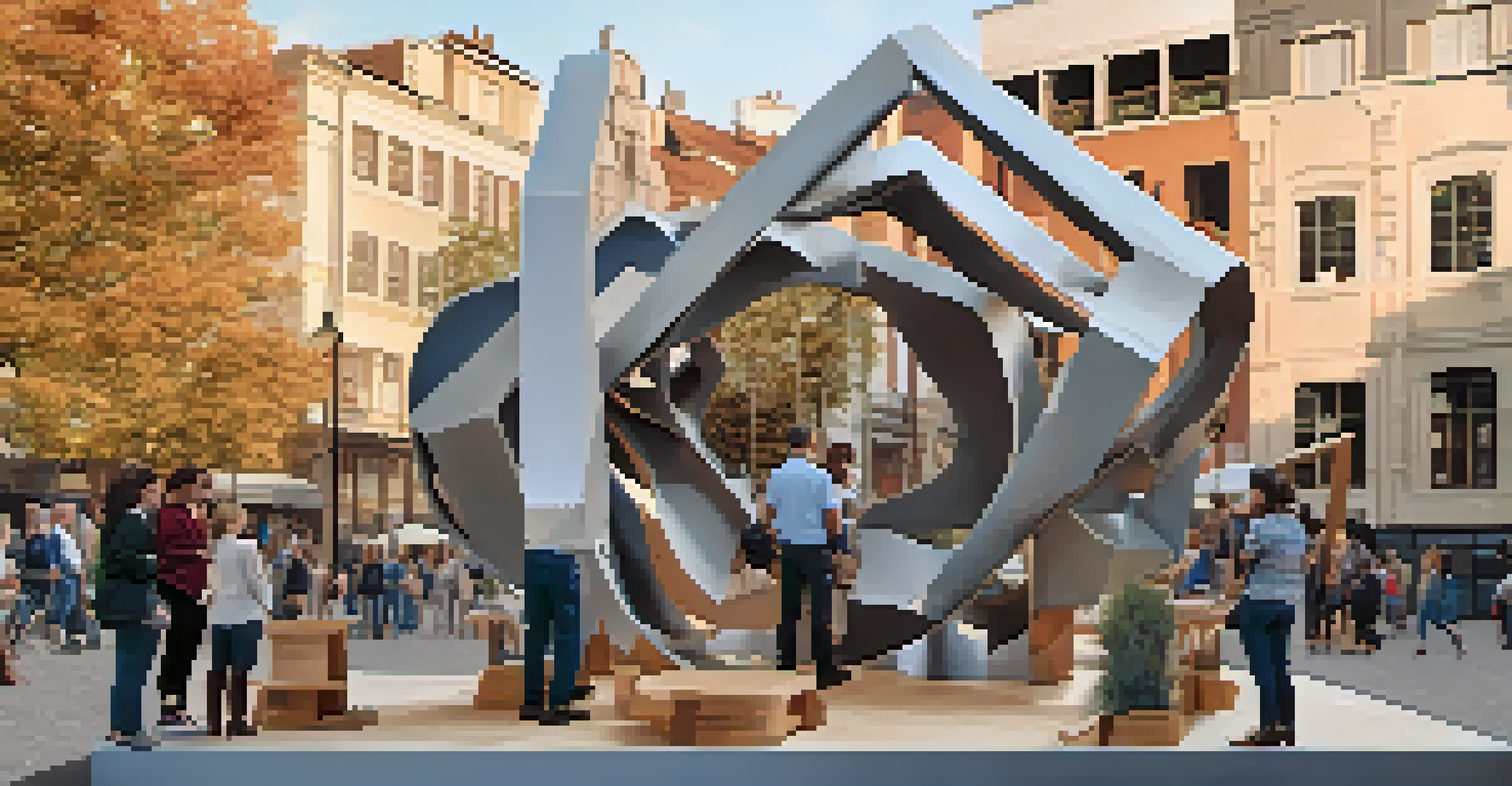The Role of Public Art in Urban Revitalization Projects

Understanding Urban Revitalization and Its Challenges
Urban revitalization refers to efforts aimed at rejuvenating neglected or declining neighborhoods. These projects often face challenges such as funding gaps, community resistance, and insufficient public engagement. To navigate these hurdles, it’s crucial to implement strategies that resonate with local residents and stakeholders.
Art is not a mirror to reflect reality, but a hammer with which to shape it.
One of the most effective strategies is integrating public art into revitalization plans. Public art can serve as a beacon of hope, attracting visitors and residents alike, while also fostering a sense of pride in the community. When art reflects the identity and history of a neighborhood, it can catalyze deeper connections among residents.
Moreover, public art has the potential to transform physical spaces, making them more inviting and accessible. For example, an empty wall can become a vibrant mural that draws people in, creating a gathering place that encourages social interaction. This transformation not only beautifies the area but also reinforces the community’s unique character.
The Role of Public Art in Community Identity
Public art plays a significant role in shaping and expressing community identity. By showcasing local artists and themes, public art can tell the stories of a neighborhood, making the culture more visible and accessible. This storytelling is essential for fostering a sense of belonging among residents.

In many cases, public art reflects the history and diversity of a community, helping to bridge generational and cultural gaps. For instance, a mural that honors local heritage can educate younger generations about their roots while celebrating the uniqueness of the area. Such initiatives can strengthen community bonds and instill pride.
Public Art Boosts Community Identity
Public art enhances community identity by showcasing local stories and fostering a sense of belonging among residents.
Additionally, public art can enhance the aesthetic appeal of urban spaces, making them more attractive to visitors and potential residents. As people become more engaged with their surroundings, they’re likely to invest in their community both emotionally and financially, fueling further revitalization efforts.
Encouraging Economic Development Through Public Art
Public art can serve as a powerful engine for economic development in urban areas. When well-executed, art installations can attract tourists, boost local businesses, and create job opportunities for artists and craftsmen. This influx of economic activity can be pivotal for struggling neighborhoods.
Public art is a way of bringing communities together, of energizing streets, and of reclaiming public space for the people.
For example, a city that hosts an annual public art festival can draw visitors from outside the area, leading to increased foot traffic in local shops and restaurants. This not only benefits business owners but also fosters a vibrant local economy that can support arts initiatives in the long run.
Moreover, public art installations can increase property values in their vicinity. As neighborhoods become more visually appealing and culturally rich, homes and commercial spaces often see a rise in demand, benefiting both current residents and potential investors.
Public Art as a Tool for Social Change
Art has long been a medium for social commentary, and public art is no exception. Artists often use their work to address pressing social issues, such as inequality, racism, or environmental concerns. This can spark conversations that lead to significant social change within communities.
For instance, a mural addressing homelessness can raise awareness and foster empathy among residents, encouraging them to support local initiatives aimed at tackling the issue. By visibly confronting social challenges, public art can inspire collective action and community-driven solutions.
Economic Growth Through Art
Well-executed public art projects can stimulate economic development by attracting tourists and increasing local business revenues.
Additionally, public art can empower marginalized voices by providing a platform for expression. When artists from diverse backgrounds create works that resonate with their experiences, they contribute to a richer, more inclusive community narrative that benefits everyone.
The Importance of Community Engagement in Public Art Projects
Successful public art projects often begin with community engagement. It’s essential to involve residents in the planning process to ensure the art reflects their values, history, and aspirations. This collaborative approach fosters a sense of ownership and pride in the artwork.
Workshops, discussions, and surveys can help gather input from community members, allowing their voices to shape the outcome of the project. When people feel that their opinions matter, they’re more likely to embrace and support the art, which can enhance its impact.
Moreover, involving local artists in the process not only elevates community talent but also strengthens relationships within the area. This synergy can lead to a more cohesive vision for the neighborhood, ultimately resulting in a public art piece that resonates deeply with its audience.
Measuring the Impact of Public Art on Urban Spaces
To understand the effectiveness of public art in urban revitalization, it’s crucial to measure its impact. This can involve qualitative assessments, such as gathering feedback from community members, as well as quantitative data, like tracking economic growth or changes in foot traffic. Combining these methods provides a comprehensive view of the art's influence.
Surveys and interviews can reveal how public art affects residents' perceptions of their neighborhood. Positive feedback about increased pride or a greater sense of community can validate the project’s goals and encourage future initiatives.
Community Engagement is Essential
Involving residents in public art planning ensures the artwork reflects their values and strengthens community pride.
Additionally, tracking economic indicators, such as local business revenue or property values, can demonstrate the tangible benefits of public art. This data can serve as a compelling argument for securing funding and support for future projects, ensuring that public art remains a priority in urban revitalization efforts.
The Future of Public Art in Urban Revitalization
As cities continue to evolve, the role of public art in urban revitalization is also expected to grow. With advancements in technology and digital art, new opportunities are emerging for artists to engage with their communities in innovative ways. This evolution could lead to even more dynamic and interactive public art experiences.
Sustainability will likely play a crucial role in the future of public art as well. Artists may increasingly focus on eco-friendly materials and practices, reflecting the growing awareness of environmental issues. This approach not only enhances aesthetic value but also underscores the community’s commitment to sustainability.

Ultimately, public art will continue to be a vital component of urban revitalization projects. By fostering connections, sparking dialogue, and enhancing community identity, public art can help shape vibrant, inclusive cities that reflect the values and aspirations of their residents.